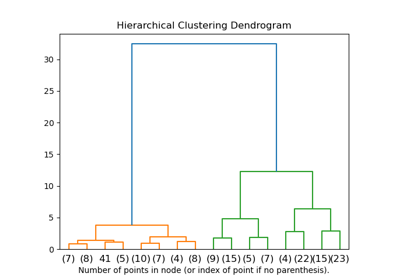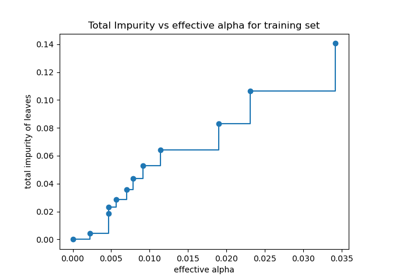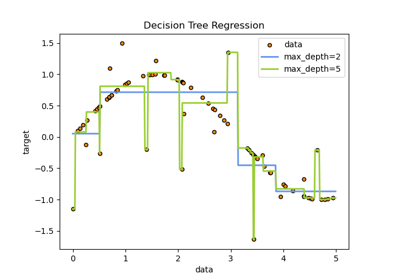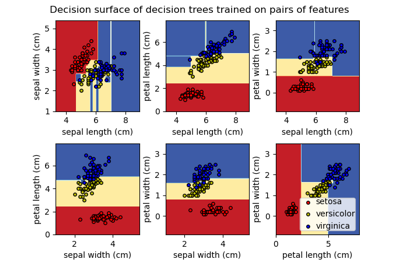注意
转到最后下载完整示例代码,或通过 JupyterLite 或 Binder 在浏览器中运行此示例。
理解决策树结构#
可以分析决策树结构,以进一步了解特征与预测目标之间的关系。在本例中,我们将展示如何检索
二叉树结构;
每个节点的深度以及它是否为叶节点;
使用
decision_path方法,样本经过的节点;使用 apply 方法,样本到达的叶节点;
用于预测样本的规则;
一组样本共享的决策路径。
# Authors: The scikit-learn developers
# SPDX-License-Identifier: BSD-3-Clause
import numpy as np
from matplotlib import pyplot as plt
from sklearn import tree
from sklearn.datasets import load_iris
from sklearn.model_selection import train_test_split
from sklearn.tree import DecisionTreeClassifier
训练树分类器#
首先,我们使用 load_iris 数据集拟合 DecisionTreeClassifier。
iris = load_iris()
X = iris.data
y = iris.target
X_train, X_test, y_train, y_test = train_test_split(X, y, random_state=0)
clf = DecisionTreeClassifier(max_leaf_nodes=3, random_state=0)
clf.fit(X_train, y_train)
树结构#
决策分类器具有一个名为 tree_ 的属性,它允许访问低级属性,例如 node_count(节点总数)和 max_depth(树的最大深度)。tree_.compute_node_depths() 方法计算树中每个节点的深度。tree_ 还存储了整个二叉树结构,表示为许多并行数组。每个数组的第 i 个元素保存有关节点 i 的信息。节点 0 是树的根。某些数组仅适用于叶节点或分裂节点。在这种情况下,另一种类型的节点的值是任意的。例如,数组 feature 和 threshold 仅适用于分裂节点。因此,这些数组中叶节点的值是任意的。
在这些数组中,我们有
children_left[i]: 节点i的左子节点 id,如果为叶节点则为 -1children_right[i]: 节点i的右子节点 id,如果为叶节点则为 -1feature[i]: 用于分裂节点i的特征threshold[i]: 节点i处的阈值n_node_samples[i]: 到达节点i的训练样本数impurity[i]: 节点i处的不纯度weighted_n_node_samples[i]: 到达节点i的加权训练样本数value[i, j, k]: 到达节点 i 的训练样本的摘要,用于输出 j 和类别 k(对于回归树,类别设置为 1)。有关value的更多信息,请参阅下文。
使用这些数组,我们可以遍历树结构来计算各种属性。下面,我们将计算每个节点的深度以及它是否为叶节点。
n_nodes = clf.tree_.node_count
children_left = clf.tree_.children_left
children_right = clf.tree_.children_right
feature = clf.tree_.feature
threshold = clf.tree_.threshold
values = clf.tree_.value
node_depth = np.zeros(shape=n_nodes, dtype=np.int64)
is_leaves = np.zeros(shape=n_nodes, dtype=bool)
stack = [(0, 0)] # start with the root node id (0) and its depth (0)
while len(stack) > 0:
# `pop` ensures each node is only visited once
node_id, depth = stack.pop()
node_depth[node_id] = depth
# If the left and right child of a node is not the same we have a split
# node
is_split_node = children_left[node_id] != children_right[node_id]
# If a split node, append left and right children and depth to `stack`
# so we can loop through them
if is_split_node:
stack.append((children_left[node_id], depth + 1))
stack.append((children_right[node_id], depth + 1))
else:
is_leaves[node_id] = True
print(
"The binary tree structure has {n} nodes and has "
"the following tree structure:\n".format(n=n_nodes)
)
for i in range(n_nodes):
if is_leaves[i]:
print(
"{space}node={node} is a leaf node with value={value}.".format(
space=node_depth[i] * "\t", node=i, value=np.around(values[i], 3)
)
)
else:
print(
"{space}node={node} is a split node with value={value}: "
"go to node {left} if X[:, {feature}] <= {threshold} "
"else to node {right}.".format(
space=node_depth[i] * "\t",
node=i,
left=children_left[i],
feature=feature[i],
threshold=threshold[i],
right=children_right[i],
value=np.around(values[i], 3),
)
)
The binary tree structure has 5 nodes and has the following tree structure:
node=0 is a split node with value=[[0.33 0.304 0.366]]: go to node 1 if X[:, 3] <= 0.800000011920929 else to node 2.
node=1 is a leaf node with value=[[1. 0. 0.]].
node=2 is a split node with value=[[0. 0.453 0.547]]: go to node 3 if X[:, 2] <= 4.950000047683716 else to node 4.
node=3 is a leaf node with value=[[0. 0.917 0.083]].
node=4 is a leaf node with value=[[0. 0.026 0.974]].
这里使用的 values 数组是什么?#
tree_.value 数组是一个形状为 [n_nodes, n_classes, n_outputs] 的 3D 数组,它提供了到达节点的样本中每个类别和每个输出的比例。每个节点都有一个 value 数组,它是相对于父节点,到达该节点的加权样本中每个输出和类别的比例。
通过将此数字乘以给定节点的 tree_.weighted_n_node_samples[node_idx],可以将其转换为到达节点的绝对加权样本数。请注意,在此示例中未使用样本权重,因此加权样本数是到达节点的样本数,因为默认情况下每个样本的权重为 1。
例如,在上面基于 iris 数据集构建的树中,根节点的 value = [0.33, 0.304, 0.366],表明根节点处有 33% 的类别 0 样本、30.4% 的类别 1 样本和 36.6% 的类别 2 样本。通过乘以到达根节点的样本数(即 tree_.weighted_n_node_samples[0]),可以将其转换为绝对样本数。然后根节点的 value = [37, 34, 41],表明根节点处有 37 个类别 0 样本、34 个类别 1 样本和 41 个类别 2 样本。
遍历树时,样本被分裂,结果是到达每个节点的 value 数组发生变化。根节点的左子节点 value = [1., 0, 0](或者当转换为绝对样本数时 value = [37, 0, 0]),因为左子节点中的所有 37 个样本都来自类别 0。
注意:在本例中,n_outputs=1,但树分类器也可以处理多输出问题。每个节点的 value 数组将只是一个 2D 数组。
我们可以将上述输出与决策树图进行比较。在这里,我们展示了到达每个节点的每个类别的样本比例,对应于 tree_.value 数组的实际元素。
tree.plot_tree(clf, proportion=True)
plt.show()
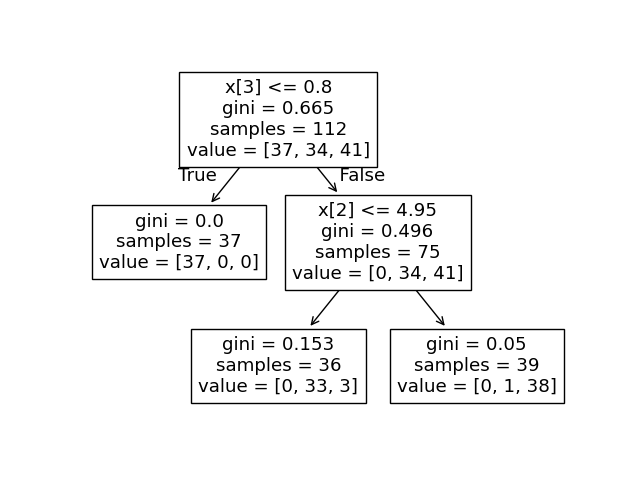
决策路径#
我们还可以检索感兴趣样本的决策路径。decision_path 方法输出一个指示矩阵,使我们能够检索感兴趣样本经过的节点。指示矩阵中位置 (i, j) 处的非零元素表示样本 i 经过节点 j。或者,对于一个样本 i,指示矩阵第 i 行中的非零元素的位置指定该样本经过的节点的 id。
感兴趣样本到达的叶节点 id 可以通过 apply 方法获得。这会返回一个数组,其中包含每个感兴趣样本到达的叶节点的节点 id。使用叶节点 id 和 decision_path,我们可以获得用于预测单个样本或一组样本的分裂条件。首先,让我们为一个样本执行此操作。请注意,node_index 是一个稀疏矩阵。
node_indicator = clf.decision_path(X_test)
leaf_id = clf.apply(X_test)
sample_id = 0
# obtain ids of the nodes `sample_id` goes through, i.e., row `sample_id`
node_index = node_indicator.indices[
node_indicator.indptr[sample_id] : node_indicator.indptr[sample_id + 1]
]
print("Rules used to predict sample {id}:\n".format(id=sample_id))
for node_id in node_index:
# continue to the next node if it is a leaf node
if leaf_id[sample_id] == node_id:
continue
# check if value of the split feature for sample 0 is below threshold
if X_test[sample_id, feature[node_id]] <= threshold[node_id]:
threshold_sign = "<="
else:
threshold_sign = ">"
print(
"decision node {node} : (X_test[{sample}, {feature}] = {value}) "
"{inequality} {threshold})".format(
node=node_id,
sample=sample_id,
feature=feature[node_id],
value=X_test[sample_id, feature[node_id]],
inequality=threshold_sign,
threshold=threshold[node_id],
)
)
Rules used to predict sample 0:
decision node 0 : (X_test[0, 3] = 2.4) > 0.800000011920929)
decision node 2 : (X_test[0, 2] = 5.1) > 4.950000047683716)
对于一组样本,我们可以确定样本经过的共同节点。
sample_ids = [0, 1]
# boolean array indicating the nodes both samples go through
common_nodes = node_indicator.toarray()[sample_ids].sum(axis=0) == len(sample_ids)
# obtain node ids using position in array
common_node_id = np.arange(n_nodes)[common_nodes]
print(
"\nThe following samples {samples} share the node(s) {nodes} in the tree.".format(
samples=sample_ids, nodes=common_node_id
)
)
print("This is {prop}% of all nodes.".format(prop=100 * len(common_node_id) / n_nodes))
The following samples [0, 1] share the node(s) [0 2] in the tree.
This is 40.0% of all nodes.
脚本总运行时间: (0 分钟 0.075 秒)
相关示例
